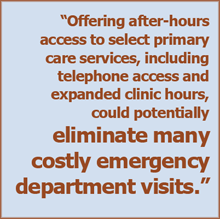Synopsis
A Commonwealth Fund–supported analysis of primary care practices that provide after-hours care to patients found that success in delivering this medical home service was closely linked to physician buy-in; effective communication bolstered by electronic health records (EHRs); adjustments to scheduling and staffing capacity, including the use of nurse triage phone lines; and an overall commitment to improving access and continuity in patient–provider relationships. Going forward, payer support will be important to increasing patients’ access to after-hours care.
The Issue
Research shows that continuity in primary care, including care received outside usual business hours, is associated with improved patient outcomes and lower emergency department (ED) use. However, fewer than 30 percent of physicians say their practice has arrangements for ensuring after-hours care for patients, other than automated phone referral to the emergency department. Medical homes are expected to provide 24/7 coverage, but there is little to guide primary care practices in developing sustainable models for accessible and coordinated after-hours care. To identify promising after-hours care models, the Center for Studying Health System Change interviewed practices and organizations that provide such care.
Key Findings
Interviews identified five different models that practices use to provide after-hours care coordinated with primary care:
-
 Work in small practices (solo or two-person) where a physician is available around-the-clock.
Work in small practices (solo or two-person) where a physician is available around-the-clock. - Form partnerships with other practices, so that physicians can rotate after-hours shifts.
- Join a small, local cross-coverage network; for example, in the Adirondack Regional Medical Home Pilot, providers cover each other’s patient panels.
- Join a large cross-coverage network, such as the Geisinger Health System in Pennsylvania, which has staffed after-hours clinics and urgent care centers.
- Enter a contractual relationship with an urgent care center or after-hours clinic.
The feasibility of after-hours care models is influenced by several factors, including:
- the degree of clinician buy-in, which may be influenced by financial incentives, or the knowledge that patients will be returned to the practice for follow-up and ongoing care;
- scheduling and staffing capacity to account for hours of greatest patient demand, and the availability of nurse triage phone lines and other tools;
- a financial model tailored to the practice’s size, payer mix and type, and socioeconomic status of patients, and whether the practice is part of a system bearing the costs for ED and hospital utilization;
- effective communication between PCPs and after-hours providers, supported by EHRs, and consistent communication with patients about when and how to seek after-hours care; and
- the practice’s overall commitment to improving access to care.
Practices noted the following challenges to after-hours care: obtaining reimbursement, even when proper billing codes are used; obtaining physician collaboration outside the practice; and changing the behavior of patients who are accustomed to using the ED for nonemergent care.
Addressing the Problem
It may be challenging for autonomous small practices to work together to share on-call shifts or telephone triage, but practices that share resources can more feasibly provide after-hours care and track and manage patient information, the authors conclude. EHRs, systematic notification processes that prompt clinicians to review notes from after-hours care, and Web-based secure data repositories that allow on-call and after-hours care providers access to information will all be crucial to ensuring continuity in after-hours care arrangements.
About the Study
The authors interviewed 44 primary care physicians, practice managers, nurses, and health plan representatives from 28 organizations in 16 states.
The Bottom Line
Overall, primary care offices that successfully provide after-hours care achieve physician buy-in, have effective communication bolstered by EHRs, make appropriate staffing adjustments and use tools like nurse triage phone lines, and make an overall commitment to improving access and continuity in patient–provider relationships.